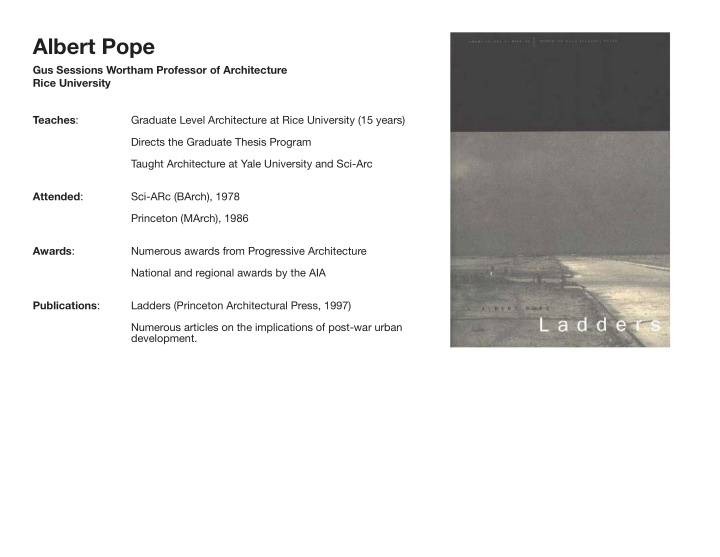



Albert Pope Gus Sessions Wortham Professor of Architecture Rice University Teaches : Graduate Level Architecture at Rice University (15 years) Directs the Graduate Thesis Program Taught Architecture at Yale University and Sci-Arc Attended : Sci-ARc (BArch), 1978 Princeton (MArch), 1986 Awards : Numerous awards from Progressive Architecture National and regional awards by the AIA Publications : Ladders (Princeton Architectural Press, 1997) Numerous articles on the implications of post-war urban development.
Van Eyck’s Dilemma (lecture at Parson’s SCE 11/05/2010) “if society has no form, how can architects build the counterform?”
City Superseeded Van Eyck was Wrong “The logic of an urban present has been introduced and developed both within the diciplinary con fi nes of modern architecture as well as half a century of urban production.” Sprawl is not formless . It has it’s own unique structural logic.
The Evolution of Megalopolis Chicago, Illinois 1 2 3 MEGALOPOLIS DID NOT DROP FROM THE SKY - it is an ongoing evolution in a line of aggregate urbanisms that came before” Today’s city “has been in formation throughout the twentieth century and Hilberseimer merely abstracted it to the point that we could fi nally grasp its logic.”
The Scope of Megalopolis Rockford, Illinois 1 2 4 3 The spine is the DNA of the Megalopolis.... of sprawl.
, 1 The Origin of the Settlement Unit Elkhorn, Wisconsin Stage 1 : Ideal American farming town - gridiron organization , b l PHASE 2 ELKHORN WISCONSIN 2 Stage 2: Connections between town and Hinterland replaced by national highway 3 Stage 3: 6 levels of hierarchy replace gridiron: Interstate, Frontage road,Local exit, Collector, and 2 levels of Residential streets
Discontinuity ���������� Megalopolis city ����������� ��������� prison Metropolis ������������
On Subjectivity Informal, Overlapping and Simultaneous 2 level Hierarchy:STREET/DESTINATION below OPEN DIFFERENTIATED NETWORKS ral feature. The subjectivities of the superblock correspond precisely to the in- projects as Frank Lloyd Wright’s Broadacre City and Llewelyn-Davies’ Milton North America. The superblock encodes another level of hierarchy within the Keynes. They are also characteristic of the immediate postwar subdivision in urban infrastructure. With the addition of the boulevard, the superblock shows utterly changed. Superblocks are the organizational unit of such well-known words, the same networks can be formed, but the dynamic between them is of entrances and exits that typically occur in superblock development. In other more easily isolated as a result of a defined perimeter and the reduced number Besides being locked into the infrastructure, these subjectivities can also be frastructural form such that a ‘lock’ between program and structure is created. a third level of hierarchy non-existent in the gridiron. This three-level hierar- chy can be expressed as BOULEVARD/STREET/DESTINATION. Some Restriction of Events 3 level Hierarchy: BOULEVARD/STREET/DESTINATION Separation of Events 6 level Hierarchy: FREEWAY/FEEDER/BOULEVARD/ SPINE/STREET/DESTINATION
On Subjectivity
Counterform Fifth Ward District, Houston, Texas disribution integration street ������������ ����������� ����������� Since different programs have different continuities, by indexing intersections, levels of continuity can be quanti fi ed and translated directly into new networks of intesections.
From Typology to Form 2.14 1.4 3.7 5.3 4.16 6.16 7.0
Recommend
More recommend